Welcome to memoQ editor
The new memoQ editor is our fresh take on the classic webtrans offering a redesigned interface, improved wording, and enhanced functionalities. It is available from memoQ TMS 11.4.
Who can use memoQ editor?
memoQ editor is part of memoQ TMS and is available only to organizations with a memoQ TMS subscription.
While companies manage the licensing, translators are the ones using the tool on a daily basis:
-
In-house translators – can use a Linguist license provided by their company.
-
Freelance translators – can access memoQ editor via a Linguist license assigned by a client for specific projects. However, they can’t buy memoQ editor for personal use.
Below, you'll find an overview of the interface and key features to help you get started.
How to get here
-
You receive an email from your customer's memoQ TMS. Click the link in the email to open memoQweb in your browser.
If you know the URL of the memoQ TMS where you need to work, simply open it in a browser.
-
Sign in with the user name and password you received from your customer.
-
The new memoQ editor opens.
The welcome screen appears first for all the users. Click Let’s start! to begin translating.
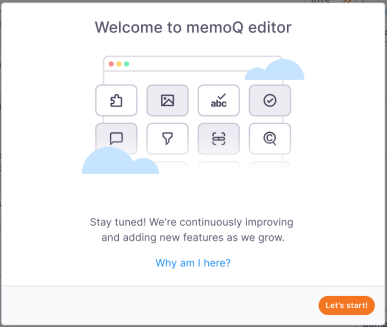
If you clicked Why am I here?, you’re reading this guide.
Let's explore the interface
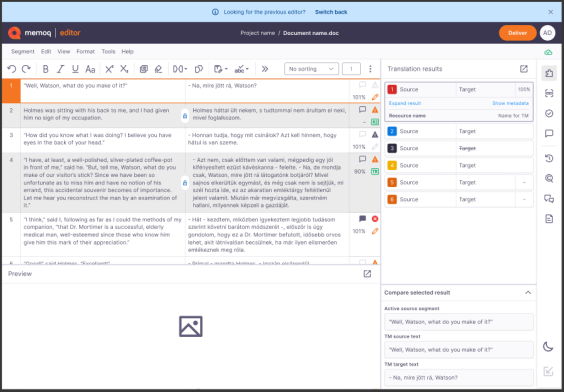
memoQ editor consists of the following key areas:
-
 Banner - to switch between editors
Banner - to switch between editors
Use it if you would like to switch from the new memoQ editor to the classic webtrans.
This allows you to continue working with familiar features while we enhance the new memoQ editor based on user feedback.
How to switch back to webtrans?
-
Click Switch back in the banner at the top of the page.
-
If the banner is no longer visible, click Help in the top menu and select Switch back to the previous editor.
Your feedback is crucial in shaping the new memoQ editor, so if you switch back, let us know what’s missing so we can improve the tool and your experience.
Make sure to switch on the anonymous data sharing so we can receive your feedback.
What happens when you switch?
-
Once you switch, you can continue working in the classic webtrans.
-
If you want to return to the new memoQ editor later, use the Try the new editor button in the header.
You can switch between the two editors at any time.
-
When a new version is released, and you open your memoQ editor, you’ll see the What’s new in memoQ editor screen. You can still switch back if the new version doesn’t yet have all the features you need.
-
-
 Top menu
Top menu

This is your translation toolbox.
Here, you can:
-

Use Bold, Italic, Underline, Toggle case, Superscript, and Subscript above the source column. Use Undo and Redo buttons for quick changes. All formatting options are also available under the Format tab.
-
Edit and manage text
You can find Cut, Copy, Paste, and Add comments options under the Edit tab.
-

To work with tags, use Copy next tag sequence and adjust Tag format display - you can choose from short, medium, or long.
Find these options above the grid or under the View tab.
-
Track changes and check spelling

memoQ editor lets you Track changes in your translation and Check spelling and get suggestions. You can find these options above the grid or under the Tools tab.
-
Use shortcuts, one of the
 buttons above the grid, or click the Segment tab in the top menu and choose an option you need from there.
buttons above the grid, or click the Segment tab in the top menu and choose an option you need from there.You can also Copy source to target
 if the source text shouldn't be translated.
if the source text shouldn't be translated. -
Filter, find, and replace text

There’s also an option to Filter your translation for a specific word or phrase, as well as and option to Find and replace phrase with another suggestion.
-
Decide how you want your Preview to look like
You can Move it to the top of the page or just Hide it if you don’t need it now.
Don’t worry, you can bring your hidden preview back at any time. To work with your Preview options, click the View tab and then choose Preview.
-
Need more help?
If you need more help and explanation, under the Help tab click Documentation.
If you want to switch back to the classic webtrans, under the Help tab click Switch back to the previous editor. When switching, make sure to let us know what’s missing in our new app so we can use your feedback to improve it.
-
-
 Translation grid
Translation grid
Here’s where your translation magic happens.
The grid shows two columns:
-
the left column contains the source text
-
the right column is where you enter and edit your translation
All segments are numbered for easy navigation and show icons providing additional info about each segment. For example, if there are any warnings, errors, or if the segment was confirmed by a translator or reviewer.
For smoother and faster workflow, you can use shortcuts.
-
-
 Right-side panel
Right-side panel
That's your main control panel for translation tasks.
Here, you can find:
-
Row history (coming soon)
-
Do you like working on multiple screens?
With memoQ editor you can open some panels - like Translation results, QA issues, and Comments - in separate windows. This allows you to customize your workspace to suit your preferences and needs.
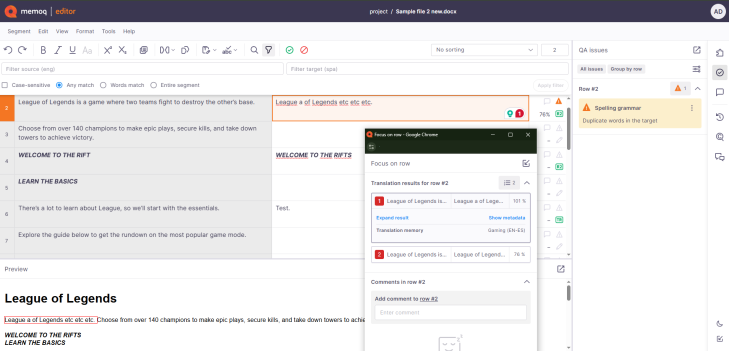
Here’s how to do that:
-
Click the Pop-out
 icon in the top-right corner of the selected feature.
icon in the top-right corner of the selected feature. This way you can for example see your translation results next to the grid but have all your QA issues and all your comments in 2 different windows (either on the same big screen or on a different display). You can also display the preview in the full screen mode on another monitor. This helps you keep everything organized and easy to access.
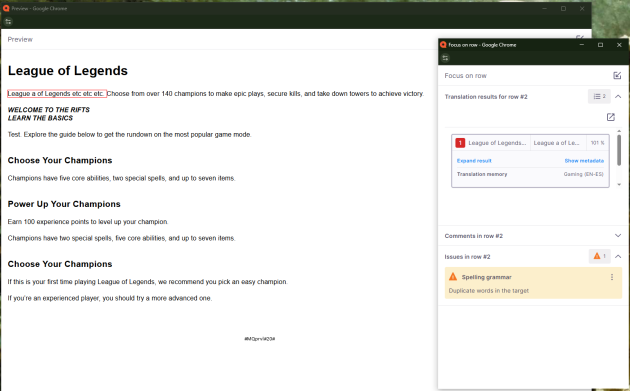
-
To bring a popped-out window back, click the Pop-in
 icon.
icon. If you have a few features popped-out and you want to reset everything to the default layout, click the Default layout
 icon.
icon.
-
 Preview pane
Preview pane
The preview pane provides a real-time preview of your document. You can Move it to the top of the page or Hide it if you don’t need it. You can always bring it back later.
To work with your Preview options, click the View tab and then choose Preview.
Now, you can start translating with memoQ editor
You can start translating right away:
-
Type your translation or select a suggestion from the Translation results panel.
Need more translation results? You can look for additional ones in the right-side panel.
-
If you need to focus on a specific row and you want to get all the important information about it, click the Focus on row
 icon in the right-side panel.
icon in the right-side panel. -
Press Ctrl + Enter to confirm and move to the next segment.
Want to use more shortcuts during your work? Check our shortcuts list.
-
Then, review and validate your translation.
To make is faster and easier, use QA checks and warnings:
-
Deliver your translation, but first, check if there are no segments that still need your attention.
-
To Switch to dark mode, click the moon
 icon in the bottom-right corner. The layout switches to the dark mode, but the Preview pane remains in a default light mode.
icon in the bottom-right corner. The layout switches to the dark mode, but the Preview pane remains in a default light mode.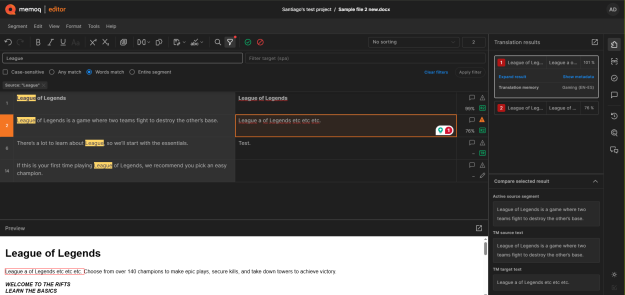
To switch back to light mode, click the sun
 icon.
icon. -
If you like working with multiple screens you can click the Pop-out
 icon to open the selected part of the memoQ editor in a separate window. You can move it to a different area of the screen or another screen for a clearer, more eye-friendly view.
icon to open the selected part of the memoQ editor in a separate window. You can move it to a different area of the screen or another screen for a clearer, more eye-friendly view.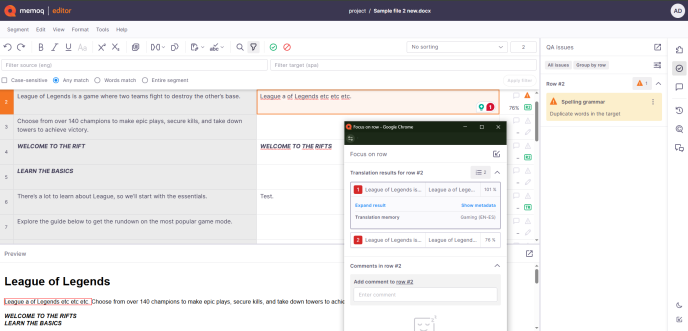
To bring it back, click the Pop-in
 icon.
icon.To reset the layout, click the Default layout
 icon in the bottom-right corner of the main screen.
icon in the bottom-right corner of the main screen.